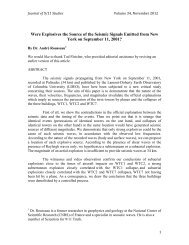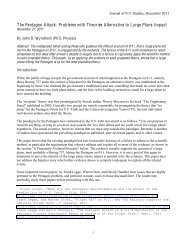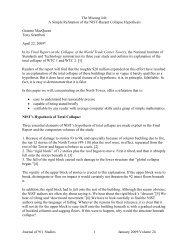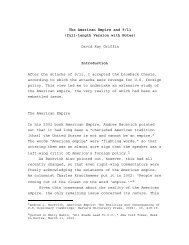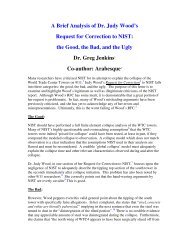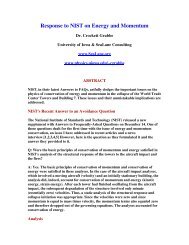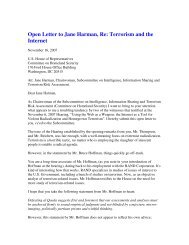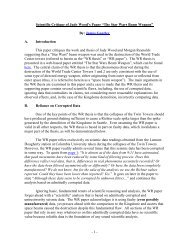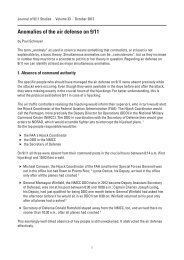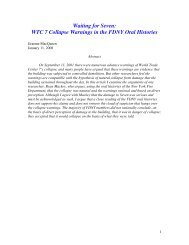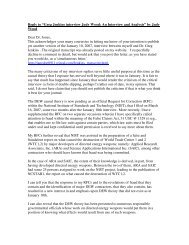interview with dr. judy wood and dr. greg jenkins - Journal of 9/11 ...
interview with dr. judy wood and dr. greg jenkins - Journal of 9/11 ...
interview with dr. judy wood and dr. greg jenkins - Journal of 9/11 ...
Create successful ePaper yourself
Turn your PDF publications into a flip-book with our unique Google optimized e-Paper software.
debatable if most the pulverizable material was strictly converted into ‘dust’ (between 1<br />
<strong>and</strong> 100 microns) on average rather than gravel (greater than a millimeter). Although<br />
much dust certainly did exist, it is difficult to estimate if dust represented the majority <strong>of</strong><br />
the pulverizable material in the buildings by weight.<br />
18 Jenkins, The Overwhelming Implausibility <strong>of</strong> DEW, page 2.<br />
19 Ibid. page 5. The Energy required is “over 5 times the total power output <strong>of</strong> the<br />
entire earth including all carbon combustion, nuclear power, wind power,<br />
hy<strong>dr</strong>oelectric power, etc. This is <strong>with</strong> no loss.”<br />
20 The reflectivity <strong>of</strong> steel in the microwave spectrum is over 99.9%. For comparison, a<br />
very good bathroom mirror (usually made from a thin coating <strong>of</strong> aluminum on glass) is<br />
only about 93% reflective in the visible spectrum. The reason that people should not<br />
place metallic objects in the microwave is because the near perfect reflection can cause<br />
damage to the microwave source oscillator.<br />
21 http://physics.ucr.edu/~wudka/Physics7/Notes_www/node6.html “There is a very<br />
important characteristic <strong>of</strong> a scientific theory or hypothesis which differentiates it from,<br />
for example, an act <strong>of</strong> faith: a theory must be ‘falsifiable’. This means that there must be<br />
some experiment or possible discovery that could prove the theory untrue.”<br />
22 This is worth trying if you haven’t already. However, only leave it in for a few<br />
seconds or you will begin to burn/melt the plastic substrate which may possibly contain<br />
toxic fumes.<br />
23 For instance, this effect is used in arc-welding (using energy in the form <strong>of</strong> plasma).<br />
24 Jenkins misspoke here: he should have said ‘…<strong>and</strong> the paper in the towel does not<br />
absorb microwaves.’<br />
25 This mechanism is simple. Water has an electric dipole moment. In the microwave<br />
spectral region, the water molecule tends to align <strong>with</strong> the electric field. Since the electric<br />
field is flipping up <strong>and</strong> down rapidly, the water will flip up <strong>and</strong> down at the same<br />
frequency. That is, the electromagnetic radiation will cause the water molecule to ‘spin’.<br />
This causes localized movement <strong>of</strong> atoms in the vicinity <strong>of</strong> the water, which is<br />
synonymous <strong>with</strong> increasing the temperature. Thus, your food is heated up by jostling the<br />
water molecules.<br />
26 ‘Some kind <strong>of</strong> energy’ is much too vague for substantive discussion. Exciting an<br />
element (as opposed to molecules or solids) is generally understood by scientists to mean<br />
exciting the electrons to higher energy states associated <strong>with</strong> that element.<br />
27 To excite electrons in an atom, the energy required depends upon the specific element<br />
as well as the particular electronic states associated <strong>with</strong> the element. However, scientists<br />
frequently speak in terms <strong>of</strong> ‘scales’ when speaking in general terms. For instance, the<br />
scale associated <strong>with</strong> the amount <strong>of</strong> energy in food is ‘hun<strong>dr</strong>eds <strong>of</strong> calories’. The scale<br />
used when speaking about the energy required to excite electronic states in elements is<br />
‘an eV’, electron volts. A single eV equals 3.9 x 10 -20 calories.<br />
Excitations in solids <strong>with</strong> a crystalline type substrate, where a regularly repeating lattice<br />
may be defined, is discussed in terms <strong>of</strong> the ‘energy b<strong>and</strong>s’. That is, all the electronic<br />
states from the singular elements which make up the lattice overlap <strong>and</strong> add up in such a<br />
way as to form continuous energy b<strong>and</strong>s. Some electrons become mobile described by the



